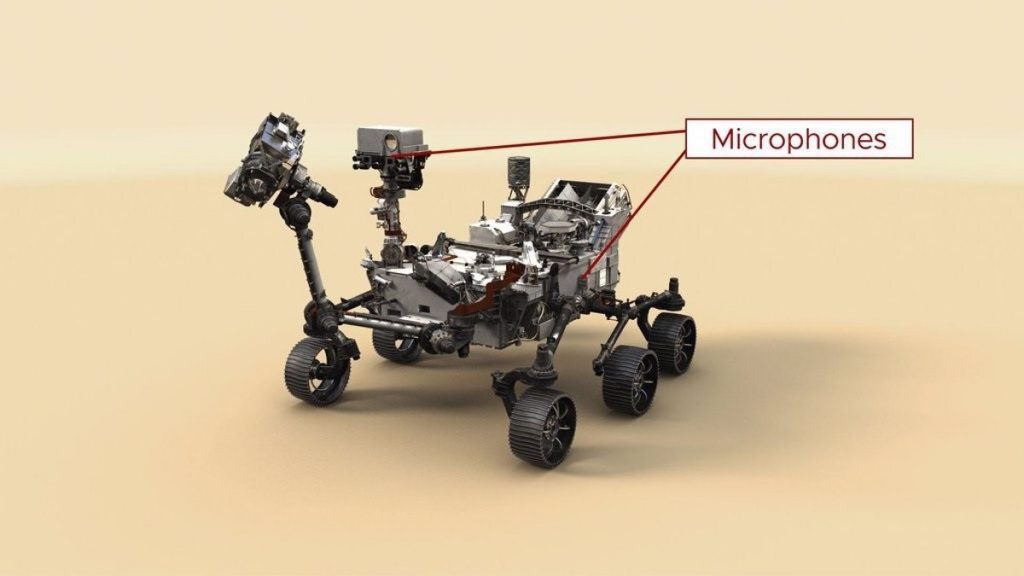Perseverance saves 5 hours of audio recordings on Mars

MADRID, October 19 (European press) –
Two microphones aboard NASA’s Perseverance rover roaming Jezero Crater on Mars add to the attraction. A new dimension to the way scientists and engineers are exploring the Red Planet.
The mission registered its arrival in February Nearly five hours of Martian winds blow, rover wheels creak on gravel, and engines hum as the six-wheeled robot cranks its arm. These sounds allow scientists and engineers to experience the Red Planet in new ways, and everyone is invited to listen.
“It feels like you’re really there,” he said. It’s a statement Baptiste Chedd, a planetary scientist studying microphone data at the Institute for Astrophysical Research and Planning in France. “The sounds of Mars have strong bass vibrations, so when you put the headphones on, you can really feel it. I think the microphones will be an important resource for future science on Mars and the solar system.” Video From the Jet Propulsion Laboratory (JPL) includes a selection of images and audio.
Perseverance is the first spacecraft to record the sound of the Red Planet using dedicated microphones, Both are commercially available devices. One of them travels on the side of the rover chassis. The second microphone is located on the persistence mast as a complement to the SuperCam laser instrument’s investigations of rocks and air.
The first was provided by NASA’s Jet Propulsion Laboratory in Southern California, while the SuperCam instrument and its mast microphone were provided by Los Alamos National Laboratory (LANL) in New Mexico and a group of laboratories. Research centers are sponsored by Centro Nacional d’Etudes Spatiales (CNES).
More than 25,000 laser shots
SuperCam studies rocks and soil with a laser and then analyzes the resulting vapor with a camera. Since the laser pulses up to hundreds of times per target, the chances of picking up the sound of those slides multiply quickly: the microphone has already recorded more than 25,000 laser shots.
Some of these recordings teach scientists about changes in the planet’s atmosphere. After all, sound is transmitted through vibrations in the air. From his perseverance mast, The SuperCam microphone is ideally located for monitoring “micro perturbations” (Minimum Air Changes) and complements the rover’s dedicated wind sensors, which are part of an atmospheric instrument cluster called MEDA, short for Mars Environmental Dynamics Analyzer.
MEDA sensors sample wind speed, pressure, and temperature once or twice per second for up to two hours at a time. The SuperCam microphone, on the other hand, It can provide similar information at a rate of 20,000 times per second for several minutes.
“It’s like comparing a magnifying glass to a microscope with a magnification of 100 times,” said MEDA principal investigator José Rodríguez-Manfredi, of the Center for Astrobiology (CAB) of the National Institute for Space Technology in Madrid. “From a meteorologist’s point of view, every perspective, detail, and context complement each other.”
The microphone also makes it possible to investigate how sound propagates on Mars. Because the planet’s atmosphere is much less dense than Earth’s, scientists knew that high pitched sounds would be difficult to hear in particular. In fact, some scientists, who weren’t sure they heard anything at all, were shocked when the microphone picked up the blaring rotors of an Ingenuity helicopter during its fourth flight, on April 30, From a distance of 80 meters (262 feet).
The information from the helicopter’s sound allowed the researchers to remove two of the three models that had been developed to predict how sound would spread on Mars.
“Sound on Mars goes further than we thought,” said Nina Lanza, a SuperCam scientist working with microphone data at LANL. “It shows you how important it is to do field science.”
There is another aspect of space exploration that can benefit from an audio dimension: spacecraft maintenance. Engineers use the cameras to monitor tire wear on the Curiosity rover and dust accumulating on InSight’s solar panels. Using microphones, they can also check the performance of a spacecraft in the same way that mechanics can listen to a car’s engine.
The Perseverance team makes a large number of recordings for the rover’s body microphone, which is well located to hear its wheels and other interior parts. Although there aren’t enough recordings yet to detect changes, over time, engineers can analyze that data and discern subtle differences, such as additional electric current going to a particular wheel. This would be in addition to the ways they are already monitoring the health of the spacecraft.
“We like to hear these sounds regularly,” said Vandy Verma, Perseverance Chief Engineer for Robotic Operations at JPL. “We routinely hear changes in sound patterns in our test vehicle here on Earth, which could indicate an issue that needs attention.”

“Future teen idol. Hardcore twitter trailblazer. Infuriatingly humble travel evangelist.”




:quality(85)/cloudfront-us-east-1.images.arcpublishing.com/infobae/BNGH73UCKQAZSQPCODUWO2BE5Y.jpg)





